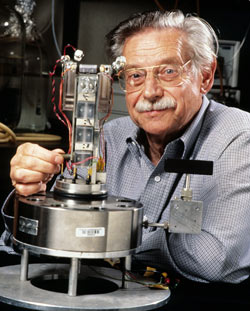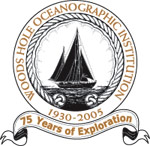This is an archived site. This site is no longer being maintained or reviewed for broken links.
Employee Portrait Gallery—Holger Jannasch
 |
|
|
This portrait of Holger Jannasch appeared on the cover of Woods Hole Currents in the summer of 1997, a year before he died. The instrument is an isolation chamber that Holger and colleagues developed for studying deep-sea bacteria under pressure. (Photo by Tom Kleindinst)
|
“Science is an adventure, not a career,” Holger Jannasch told an Institution interviewer in 1971. Science brought this microbiologist many adventures, from studies at Lake Kivu in eastern Zaire and high-altitude salt lakes in Tibet to 35 oceanographic research voyages and 23 Alvin dives between 1964 and 1998. His first venture with Alvin resulted from an extended dive three lunches made when the sub sank following a launch accident in 1968. The lunches were soggy but nearly intact when Alvin was recovered nearly a year later, leading Holger to initiate investigations of the effect of high pressure and low temperature on deep-sea bacteria. At the time, his group had no way to prevent decompression of samples brought to the surface, so they began with in situ research, then developed samplers that maintained pressure when brought to the surface, and later obtained pure cultures under pressure. Their findings concluded that the deep sea’s icy temperatures and crushing pressures slow bacterial metabolism by as much as 100 times.
Born in Germany in 1927, the young Holger enjoyed hiking, skiing, and tending several aquaria he kept at home. He was drafted into the German army at 15 and sent to Berlin to man anti-aircraft batteries. After the war, he finished high school, worked as a bird warden on an isolated island and crewed on fishing steamers, then attended the University of Göttingen, completing a Ph.D. in 1955. Returning to Germany following a postdoc at the University of Wisconsin, he first visited WHOI in 1959 and eventually joined the staff in 1963. Though he retained German citizenship, Holger spent the rest of his career here. His research focused on three major areas, microbial growth in seawater, the effects of low temperature and high pressure as noted above, and microbial processes at hydrothermal vents. He received WHOI’s Bigelow Award in 1980 and a different kind of honor in 1996 when a newly identified vent microbe was named Methanococcus jannaschii.
Upon receiving a rare designation as a foreign member of the U.S. National Academy of Sciences in 1995, he wrote, “I am greatly obliged to my Woods Hole coworkers . . . especially Carl Wirsen and Stephen Molyneaux who did most, and in recent years, all the bench work in my laboratory with unfailing reliability and increasingly with their own input.” At the time, Carl had worked in Holger’s lab for 27 years and Steve for 20. Over the years Holger’s lab also hosted a distinguished cadre of postdocs, many from Europe, but Holger’s most lasting impact on students was through his long association with the Microbial Diversity course at MBL that he helped found in the 1970s.
[back]

